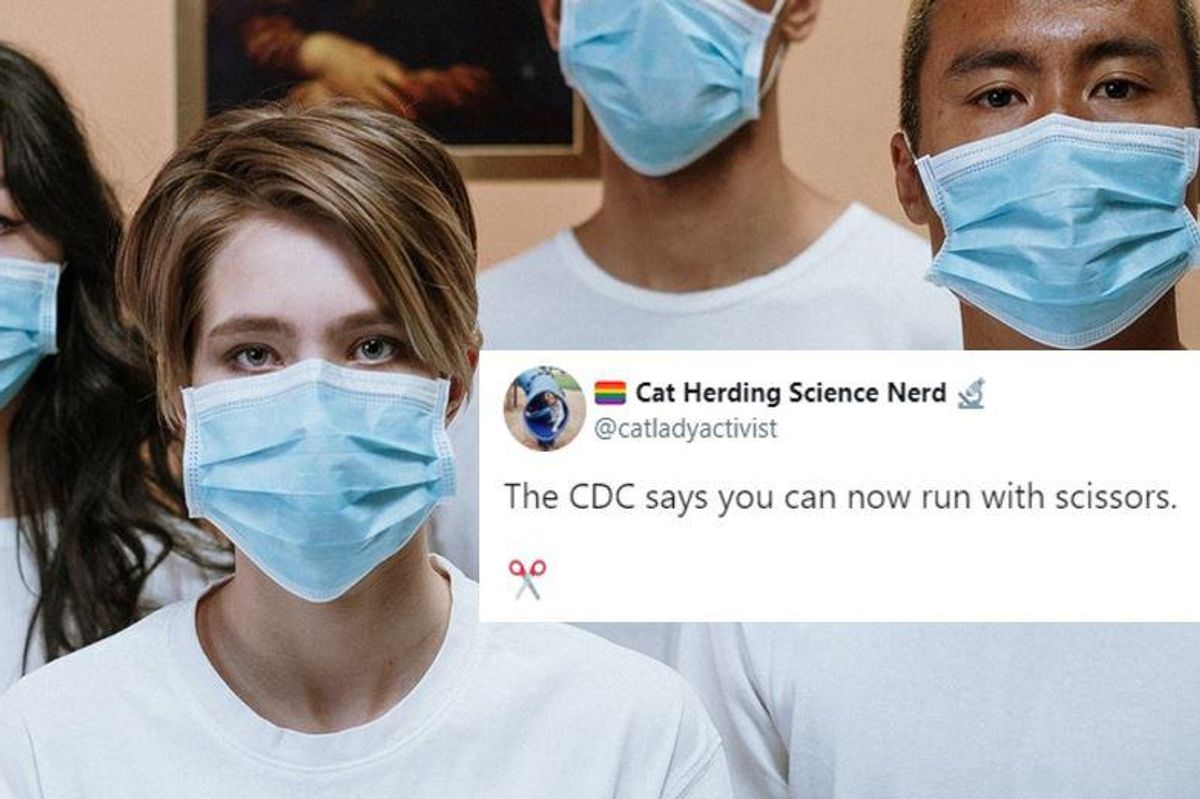The CDC reduced COVID isolation time and people are joking about the 'bad advice' that'll come next

The CDC changed its COVID-19 isolation guidelines on Monday in a move that confused a lot of people. The CDC now recommends that asymptomatic people infected with COVID-19 isolate for five days, instead of 10.
It also recommends that after isolation, those who were infected wear a mask for five days while around others.
The move comes at a time when there has been a major rise in cases across the country due to the omicron variant. The decision has a lot of people asking, “Why are we sending people who’ve been infected out in public sooner when the number of cases is on the rise?”
There has also been anxiety among the business community that an increase in isolated employees may lead to staffing shortages across the country. So is the CDC just bowing to the business community or is there a good reason for us to be more relaxed about a deadly disease?
“The Omicron variant is spreading quickly and has the potential to impact all facets of our society. CDC’s updated recommendations for isolation and quarantine balance what we know about the spread of the virus and the protection provided by vaccination and booster doses,” CDC Director Dr. Rochelle Walensky said in a statement.
“These updates ensure people can safely continue their daily lives,” she added. “Prevention is our best option: get vaccinated, get boosted, wear a mask in public indoor settings in areas of substantial and high community transmission, and take a test before you gather.”
There are a lot of people out there who think reducing isolation periods at a time when infections are on the rise is a really bad idea. So a group of people on Twitter decided to do the only thing we can in such crazy times, have a laugh.
The Twitter users have been speculating on other pieces of bad advice the CDC may come out with in the future. Here are 16 of the funniest.
cdc says go ahead and get bangs— Ygrene\u2122 (@Ygrene\u2122) 1640707041
No, don't get bangs.
cdc says if you can lean you can clean— rava (@rava) 1640659894
People are a little suspicious that the CDC is kowtowing to business interests.
The CDC says if you blow weed smoke in a paper towel roll while covering the hole with a dryer sheet your mom won\u2019t smell it.— La Befana (@La Befana) 1640712034
The worst piece of advice you'll ever get in high school.
The CDC says it is now OK to go in against a Sicilian when death is on the line.— Michael G. Bazemore (@Michael G. Bazemore) 1640748070
Vizzini begs to differ.
CDC says you can now eat the Silica Gel packet if you\u2019re feeling a little peckish— basement fire (@basement fire) 1640704022
You can eat the packet that says "DO NOT EAT" if your boss says it's ok.
The CDC says you can now wipe back to front— Bog Witch Energy (@Bog Witch Energy) 1640645088
No comment.
the cdc says you can check out any time you like but you can never leave— maura quint (@maura quint) 1640755214
In 2022, Don Henley will become the CDC director.
the cdc says sex is just so much better without a condom and promises to pull out— alyssugh (@alyssugh) 1640722263
The CDC pinky swears it will.
The CDC says you can now ask \u201cwhat are we\u201d after 5 dates.— Alexandra Bucky Variant Chaos Magic Anderson (@Alexandra Bucky Variant Chaos Magic Anderson) 1640653938
The CDC is so needy these days.
The CDC says you can now run with scissors.— \ud83c\udff3\ufe0f\u200d\ud83c\udf08 Cat Herding Science Nerd \ud83d\udd2c (@\ud83c\udff3\ufe0f\u200d\ud83c\udf08 Cat Herding Science Nerd \ud83d\udd2c) 1640656909
You can run with scissors, as long as you're wearing a mask.
The CDC says it\u2019s now ok to watch your dog stretch without saying \u201coooooh, BIG STRETCH\u201d— Sarah Axelrath, MD (@Sarah Axelrath, MD) 1640663316
No one can watch their dog stretch without making a comment. It's impossible.
The CDC says you actually need a note from your boss to go to the doctor— \ud83c\udf84Holiday Cheer Austin\ud83c\udf84 (@\ud83c\udf84Holiday Cheer Austin\ud83c\udf84) 1640738220
The CDC only cares about your boss these days. Your health? Not so much.
CDC says you can have either thoughts or prayers, but not both.— \ud83c\udf0a Purl \ud83c\udf0a (@\ud83c\udf0a Purl \ud83c\udf0a) 1640716860
What about ivermectin?
CDC says rub some dirt on it, walk it off— Red Army Duck (@Red Army Duck) 1640663764
The CDC is now a dad in the '70s.
The CDC says to just put some Vicks on it.— Jason Thomas (@Jason Thomas) 1640703995
Vicks cures everything.
BREAKING: cdc says it is fine to bathe with your toaster as long as you plug it in first— Incindery \ud83d\udd25 (@Incindery \ud83d\udd25) 1640646381
Clean toasters make healthy toast.
- Donald Trump Jr. used real CDC data to draw an absolutely ... ›
- The CDC says 6% of COVID deaths are only from COVID. Doctors ... ›
- No, the CDC did not drop its COVID-19 death count to 37,000. In fact ... ›

